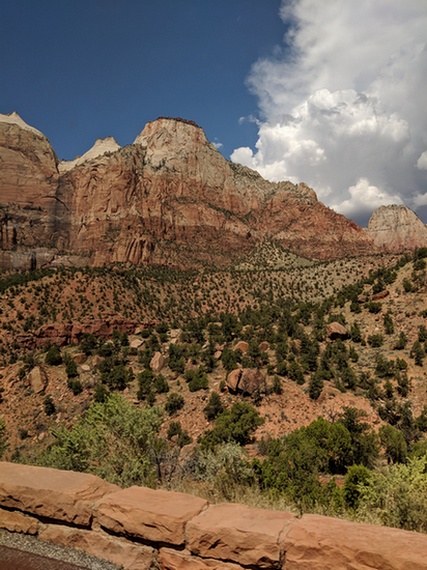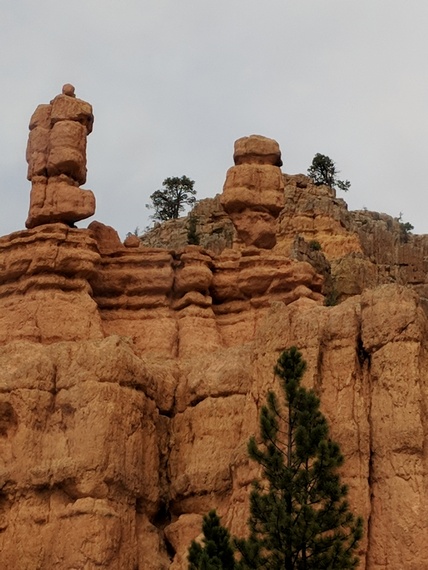

Travelogue
Zion and Bryce Canyon National Parks
A one day trek with the
brods
by Atenarai '71b
Zion National Park
On the southwestern corner of Utah lies Zion National Park whose prominent
feature is Zion Canyon that stretches 15 miles long and half a mile deep. It
sits on the intersection of the Colorado Plateau, the Great Basin and the Mojave
Desert. What makes it so unique are its geography and diversity of life
forms. The park itself encompasses mountains, buttes, mesas, rivers, canyons,
and yes - natural arches.
As one enters the park one is met by these natural arches and stone
formations that are the result of geological events that occured at different
stages in the park's 115 million year history. Traveling through the park by car
renders one to be awestruck, but I could imagine hiking in at a few stops would
reveal even more breathtaking perspectives. But since we were pressed for time
we made a beeline for our next stop, Bryce Canyon.


Temples and Towers of the Virgin
l-r: Noli Nolasco, Jun Valenzuela, Art de Vera, Rolly Reyes, Bogs Cabanatan, Edsel Arceo and Ike Araneta.
l-r: Rolly Reyes, Noli Nolasco, Edsel & Mayette Arceo, Tanya Araneta, Art de Vera, Bogs & Agnes Cabanatan, and Jun & Iou Valenzuela.
Plus Te-c Nolasco, 2nd from right.
Just to backtrack a little, this trip was born out of the urging Brod Norman
Bituin for the benefit of those brods that stayed the extra day after the UP
Beta Sigma Fraternity Southern California induction celebrations held in Las
Vegas on September 1-2. Norman, as well as Vale, have been to both Zion and
Bryce Canyon several times and encouraged us to take advantage of the time to visit
these two much revered national parks in the US. It took us two and a half hours
to get to Zion from Las Vegas and and another hour to Bryce Canyon.
Bryce Canyon National Park
The unique feature of Bryce Canyon is
that it is a collection of giant natural “amphitheaters” made up of red, orange,
and white rock that were carved by frost and stream erosion from river and lake
sedimentary rocks. The fascinating thing is that the visitor stops from which
these rock formations can be viewed from are just slightly above and yet so
close to the structures providing a whole different dimension than viewing a
structure from below as the following pictures illustrate. I was telling Vale
that it made it seem that one was entering God’s “temple”. The term that is used to
describe the rock formations is “hoodoo”.
A hoodoo (also called a tent rock, fairy chimney or earth pyramid) is a tall, thin spire of rock that protrudes from the bottom of an arid drainage basin or badland. Hoodoos typically consist of relatively soft rock topped by harder, less easily eroded stone that protects each column from the elements. They generally form within sedimentary rock and volcanic rock formations.
Bryce Canyon sits higher that Zion with its rim extending 8,000 to 9,000 feet above
the floor. Total acreage is 35, 835. According to Wikipedia it started to form
in the latter half of the Cretaceous period, a geologic period and system that
spans 79 million years from the end of the Jurassic Period 145 million years ago
(mya) to the beginning of the Paleogene Period.
While the trip logged in a total of 7 hours travel time, it was well worth
the spectacular views, the jokes and banters and slightly exaggerated stories. A
special thank you to Norman for urging us to go and to Edsel, who drove most of
the way, for bringing us safely back to Vegas.